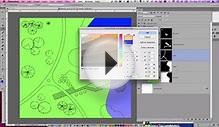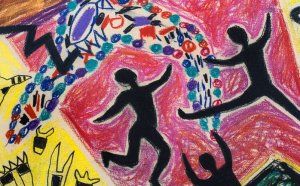
Painting to Music lesson plans
Level: Primary and up
Grades: K and up | Age: 5yrs and up | : Andrea Mulder-Slater
[Andrea is one of the creators of KinderArt.com]
Students will gain an understanding of how much of a role emotion plays in artmaking as they create paintings based on feelings.
Vocabulary:
image, feeling, emotion, idea, expression, color, texture, line, imagine, create, change, evolve, happy, sad, angry, excited, alone, bright, dull, acrylic, tempera, experience, share, design
- a large sheet of heavy paper (or canvas)
- acrylic paint (for older students)
- tempera paint - or crayons (for younger students)
- paintbrushes
- water
- containers
- mixing trays (could be styrofoam trays or sheets of old cardboard)
- paper towels
- newspapers
- old shirts or painting smocks
- music (various styles)
- scrap newsprint
- pencils
- Talk about emotion. What does the word emotion mean? What kinds of emotions do we experience on a day-to-day basis.
- Talk about color. How do certain colors make us feel? Why?
- Talk about line. What kinds of lines are there? Straight, jagged, squiggly, zig-zag, etc.
- Warm up by having students draw lines (using pencil on newsprint) based upon certain feelings. IE: draw happy lines, draw angry lines, etc.
- You can also encourage your students to draw lines based on the music they are hearing (IE: jazz, classical, pop etc.)
- Once everyone is "warmed up" begin working with the paint. Make sure each student has a paintbrush, water and access to at least the three primary colors (red, yellow and blue).
- Give a quick demonstration of how paints are used properly (always clean brushes before dipping into a new fresh color ... treat the brushes well by not squishing them down on the paper etc. Also, review color mixing (yellow + blue = green; red + yellow = orange; red + blue = violet)
- Everyone can then decide on an emotion or feeling which they will express using various paint colors, lines, textures and shapes.
- Allow your kinderartists to take as long as they need to create the final work, encouraging them to stand back from time to time to have a really good look at what they are doing. Is it moving in the direction they want it to? Are the desired feelings starting to emerge?
- Remember too that this is a very intuitive and subjective exercise and as such the works should not be analyzed by the instructor, but rather by the kinderartists themselves.
- When the paintings are complete, hang them up and see how others interpret the work. Does everyone see similar emotions in the same works? Yes? No? Why? Refer to How to Look at Art.
YOU MIGHT ALSO LIKE

Lesson Plan on World Music

Painted planes
Share this Post
Related posts
Music lesson plans for Kids
APRIL 09, 2025
Music not only has the power to stimulate the mind, enrich the heart and soothe the soul; it also helps you meet educational…
Read MoreNative American Music lesson plans
APRIL 09, 2025
Lesson Four- The Strength of Native American Music The following lesson is designed to be used after viewing all or part…
Read More










